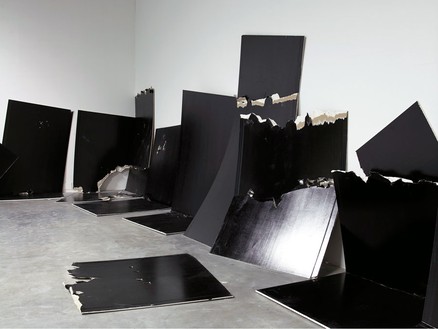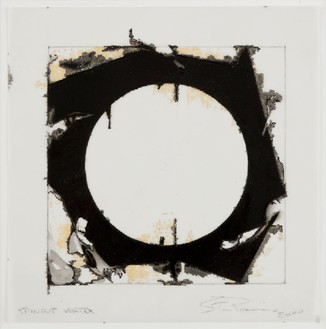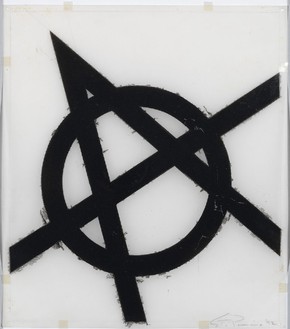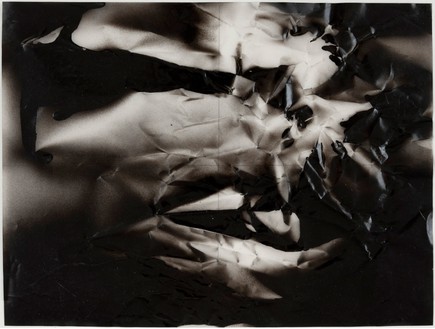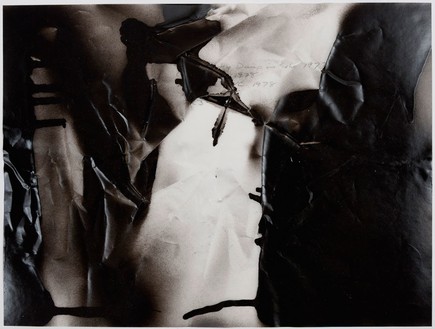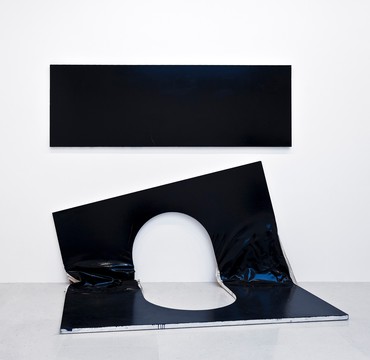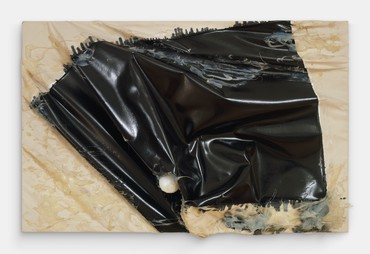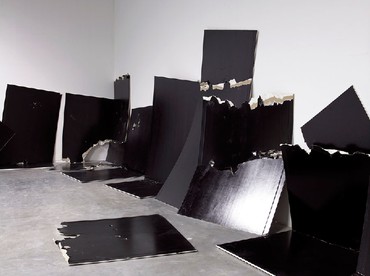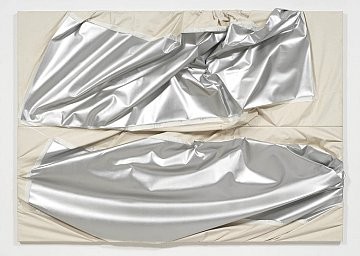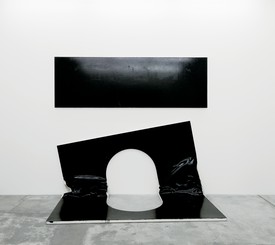About
Most are afraid of total freedom, of nothingness, of life. You try to control everything, but nature is uncontrollable. It doesn’t matter how you express yourself (words, image, electric guitar), what matters is that you have something to express.
—Steven Parrino
Steven Parrino (1958–2005) is best known for his signature “misshaped” monochromes with slashed, torn, or twisted canvases. A pioneer in performance and video art, he approached all of his work with a radicalism born out of a deep understanding of the history of painting and the avant-garde.
Parrino was born in New York and grew up on Long Island. He earned an Associate in Applied Science degree from the State University of New York at Farmingdale in 1979 and a BFA from the New School, New York, in 1982. In the late 1970s Parrino began staging impromptu performances, including: Fire Door (1979), wherein he set off the fire alarm of a building and escaped via the fire exit; Electric Guitar (1979), fifteen minutes of feedback played at high volume; and Disruption (1981), in which he smashed a TV set with a sledgehammer. Because they were improvised, most of these were not well-documented, yet their anarchic energy was made palpable in Parrino’s later paintings and three-dimensional works.
In 1984 Parrino’s paintings were shown at Gallery Nature Morte in New York’s East Village, increasing his visibility in the art world. Due to his nihilistic approach to painting, he was considered by some to be part of a strain of postmodern art called Neo-Geo, or neo-geometric conceptualism. Neo-Geo artists, such as Peter Halley, Jeff Koons, and Olivier Mosset, criticized the mechanization and commercialism of the modern world. Bob Nickas included Parrino’s work and that of several Neo-Geo artists in a group exhibition titled The Art of the Real, at Galerie Pierre Huber, Geneva, in 1987. The title was borrowed from the landmark 1968 exhibition at the Museum of Modern Art, New York, which featured works by Donald Judd, Ellsworth Kelly, Barnett Newman, Ad Reinhardt, Robert Smithson, and Frank Stella, among others. MoMA’s exhibition gathered artists whose work expressed the “real” as a set of facts rather than symbols. Nickas, with his show, posited that the Neo-Geo artists were expanding this project twenty years later.
Never completely comfortable with the “Neo-Geo” label, Parrino derived his work from his deep art-historical engagement and love of Pop iconography, and from the subversive counterculture of the Hell’s Angels, the occult, and the No Wave and punk rock movements. Hells Angels (1985) is a literal application of the formalist push-pull theory, wherein Parrino physically exercised violence upon the canvas. Frank Stella’s Cat (1992) plays with the technique Stella used in his black paintings, with their unpainted stripes, by letting the unprimed canvas intrude within the picture plane as a network of folds. And Death in America #2 (2003) echoes Andy Warhol’s Death and Disaster series (1962–63), providing a glimpse of the dark and nightmarish underbelly of the American Dream.
Parrino’s last solo exhibition during his lifetime took place at Team Gallery, New York, in 2004. It was titled Plan 9 after Ed Wood’s 1959 film Plan 9 from Outer Space, a story of the living dead. Included in the exhibition was The Chaotic Painting (2004), in which space seems to push outward, to come from elsewhere, echoing Robert Smithson’s conflation of pictorial and cosmic space. Questioning the painted canvas through piercing, tearing, and twisting it off the stretcher, Parrino redefined pictorial possibilities by blurring boundaries between formalism and counterculture.
#StevenParrino
Exhibitions
Fairs, Events & Announcements
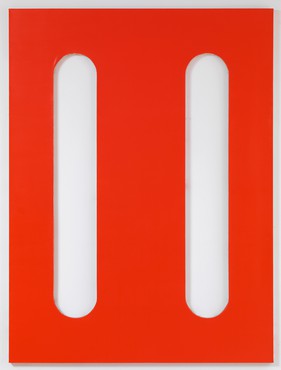
Visit
After Hours
Steven Parrino
April 4–7, 2022
Gagosian, rue de Castiglione, Paris
For four nights the rue de Castiglione gallery will be open until 8pm for after-hours viewing of Steven Parrino, an exhibition featuring manipulated canvas paintings, works in sprayed enamel on vellum, and other works on paper. The show is anchored by three large paintings: Touch and Go (1989–95), Spin-Out Vortex (Black Hole) (2000), and The Self-Mutilation Bootleg 2 (The Open Grave) (1988/2003). Initially grouped with the Neo-Geo and Appropriation artists of 1980s downtown New York, Parrino ultimately pursued a more idiosyncratic and iconoclastic vision.
Steven Parrino, Touch and Go, 1989–95 © Steven Parrino, courtesy the Parrino Family Estate. Photo: Rob McKeever
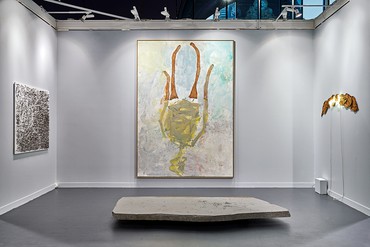
Art Fair
FIAC 2021
October 21–24, 2021, booth B23
Grand Palais Éphémère, Paris
fiac.com
Gagosian is pleased to participate in FIAC 2021 with a presentation of painting, sculpture, and works on paper by gallery artists. The booth will feature works by Georg Baselitz, Edmund de Waal, Helen Frankenthaler, Theaster Gates, Katharina Grosse, Simon Hantaï, Takashi Murakami, Albert Oehlen, Steven Parrino, Auguste Rodin, Sterling Ruby, Setsuko, Jim Shaw, and Cy Twombly, among others. A selection of the works will also appear on gagosian.com and in FIAC’s Online Viewing Room.
To receive a pdf with detailed information on the works, please contact the gallery at inquire@gagosian.com. To attend the fair, purchase tickets at fiac.com.
Gagosian’s booth at FIAC 2021. Artwork, left to right: © Giuseppe Penone/2021 Artists Rights Society (ARS), New York/ADAGP, Paris; © Michael Heizer; © Georg Baselitz, 2021; © Pier Paolo Calzolari. Photo: Thomas Lannes
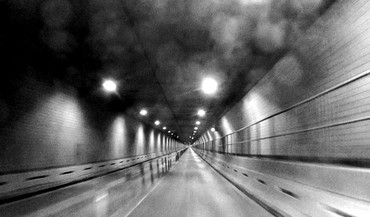
Exhibition
Broadcast
Alternate Meanings in Film and Video
You’re only as young as the last time you changed your mind.
—Timothy Leary
Gagosian is pleased to present Broadcast: Alternate Meanings in Film and Video, an online exhibition of artists’ films and videos viewable exclusively on gagosian.com. The exhibition will be organized into a series of “chapters,” each lasting two weeks. The first chapter begins on Tuesday, May 19, 2020.
Broadcast: Alternate Meanings in Film and Video employs the innate immediacy of time-based art to spark reflection on the here and now, taking the words of famed psychologist and countercultural icon Timothy Leary as its starting point.
Adam McEwen, Escape from New York, 2014 (still from “Battery Tunnel”) © Adam McEwen
Museum Exhibitions

Closed
Colección Jumex
Todo Se Vuelve Más Ligero
November 18, 2023–February 11, 2024
Museo Jumex, Mexico City
www.fundacionjumex.org
To celebrate its tenth anniversary, Museo Jumex has invited Lisa Phillips, director of the New Museum, New York, to curate an exhibition drawn entirely from the Jumex collection and occupying the whole building. Featuring work by more than seventy international artists, the exhibition, whose title translates to Everything Gets Lighter, brings together diverse works in a poetic meditation on the meaning of light and manifestations of lightness. Work by Damien Hirst, Steven Parrino, Ed Ruscha, and Rudolf Stingel is included.
Rudolf Stingel, Untitled, 2001–02, Museo Jumex, Mexico City © Rudolf Stingel
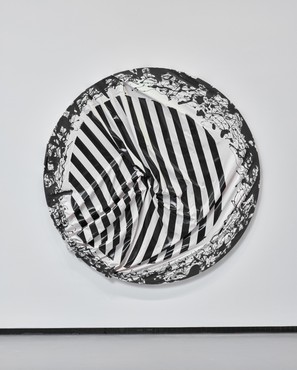
Closed
La Couleur en fugue
May 4–August 29, 2022
Fondation Louis Vuitton, Paris
www.fondationlouisvuitton.fr
This exhibition, whose title translates to Fugues in Color, features works where paint escapes the confines of the canvas, with color consuming surrounding spaces, including walls, floors, and ceilings. The diverse variations of color extend into the architecture in close interaction with the Frank Gehry–designed building. Work by Katharina Grosse and Steven Parrino is included.
Steven Parrino, Skeletal Implosion, 2001 © Steven Parrino, courtesy the Parrino Family Estate. Photo: Marc Domage

Closed
Steven Parrino
Nihilism Is Love
February 21–August 16, 2020
Kunstmuseum Liechtenstein, Vaduz
www.kunstmuseum.li
This exhibition is the first comprehensive retrospective of Steven Parrino’s work in the German-speaking world. The presentation includes early drawings and collages and several installations, and is accompanied by photographs of his concerts and videos.
Steven Parrino, Candy Stevens (Pink Disaster), 1988, Kunstmuseum Liechtenstein, Vaduz © Steven Parrino
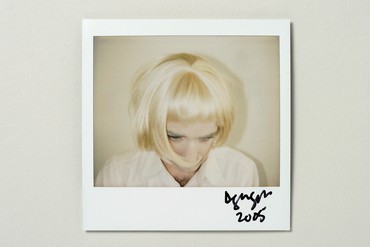
Closed
I Am a Problem
September 23, 2017–February 18, 2018
MMK 2, Frankfurt
mmk-frankfurt.de
A gloomy and at the same time provoking parallel world unfolds in the exhibition space, in which works from the Museum für Moderne Kunst’s collection become protagonists of a narrative and enter into a dialogue with one another. The starting point for the staging is a myth about Maria Callas (1923–1977). Work by Douglas Gordon, Bruce Nauman, Steven Parrino, Taryn Simon, and Andy Warhol is included.
Douglas Gordon, going out, 2005 © Studio lost but found and VG Bild-Kunst 2018. Photo by Axel Schneider
